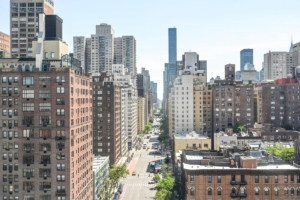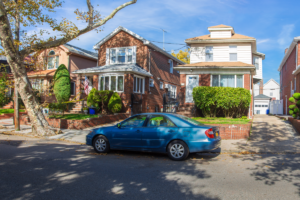New York City’s lowest-wage workers may be shut out entirely of the city’s ever-expensive rental market. According to StreetEasy rent data, New Yorkers need to earn an hourly wage of at least $38.80 to afford the city’s median asking rent of $2,690 in 2015, more than four times greater than New York State’s current minimum wage. For those workers that currently earn the state’s minimum of $8.75 per hour, there are no neighborhoods in which median asking rent could be paid affordably. The extent to which rent growth has outpaced income growth in New York City means low-wage workers face three options: find several roommates to lower their personal rent burden, take on more than one job, or move out of New York City.
The minimum wage necessary to afford median asking rent in 2015 is highest in Manhattan ($44.60), followed by Brooklyn ($35.87), Queens ($29.67), Staten Island ($26.21), and the Bronx ($21.26). Use the map below to see what the necessary wage would be to affordably rent in 2015 for each New York City neighborhood.
Central Park South, long one of New York City’s most expensive neighborhoods, requires the highest hourly wage. Residents of Central Park South need to earn an hourly wage of at least $85.07 in order to afford the neighborhood’s sky-high rents, roughly nine times the current minimum wage. Taken from another view, a worker making minimum wage would need to work 389 hours per week in order to afford rent in Central Park South. There are only 168 hours in a week, so a minimum wage worker could work every hour of every day and come up short on rent in Central Park South and 46 other neighborhoods including Tribeca, DUMBO, Stuyvesant Town, Park Slope, Williamsburg and Long Island City.
[tableau server=”public.tableau.com” workbook=”minWageAnalysis” view=”Dashboard1″ tabs=”no” toolbar=”” revert=”” refresh=”” linktarget=”” width=”600px” height=”770px”]
Proposed Minimum Wage Increase Does Little to Improve Affordability
Even if the minimum wage was increased to $15 per hour for the tens of thousands of fast food workers in New York City, as was recently recommended by a panel appointed by Gov. Andrew Cuomo, the rent affordability landscape would be largely unchanged. A New Yorker earning $15 per hour could afford just one neighborhood – Throgs Neck in the Bronx. Workers living there need to earn an hourly wage of at least $13.64 in order to afford rent. Other neighborhoods that come close to the $15 proposed minimum wage are New Dorp ($15.76), Woodstock ($16.45), Fordham ($16.79), and Far Rockaway ($17.09).
Apart from the growing cost of rent in virtually every neighborhood, low-wage workers in New York City must contend with much higher costs of living relative to other cities. According to a recent study by Pew Research, a $15 minimum wage in New York City would yield just $12.26 worth of purchasing power due to the region’s higher costs for items such as health care, groceries, and transportation.[i] A $15 minimum wage in Beckley, West Virginia, by contrast, would yield a purchasing power of $19.23. In other words, dollars do not stretch as far in New York City as they do in other, less expensive metropolitan regions, adding an extra burden for low-wage workers here.
For New York City’s Lowest Paid, Difficult Trade-Offs
Paying rent is a growing burden for most New York households. According to a StreetEasy study released in March 2015, annual rent will account for nearly 60 percent of a typical New York household’s annual income this year. For the roughly one third of all New York City workers who are employed in low paying industries such as hotels and fast food establishments, the burden is far more acute.[ii] Forced to stretch precious few dollars farther, minimum wage workers are confronted with difficult trade-offs. They can seek lower rents in areas surrounding New York City, but higher transportation costs – in terms of both actual costs and opportunity costs – will eat into their rent savings. They may also seek a second or third job, extending their work week well beyond the traditional 40 hours in order to muster enough to pay rent and put food on the table.
A minimum wage increase to $15, though hard fought by fast-food workers and supported by 73 percent of New Yorkers, may not be enough to stem the city’s growing rent burden.[iii] The extent of this burden is highlighted by the fact that just one neighborhood, Throgs Neck, would be affordable to a minimum wage worker at $15 per hour. All other neighborhoods would remain out of reach. In order to make a meaningful improvement to housing affordability, policy makers in New York City will need to target an expansion of housing supply along with income growth. As long as the city’s rent vacancy hovers at around 4 percent, as it did in 2014, New Yorkers will continue to feel the squeeze.
How We Did It
Median asking rent for each neighborhood in 2015 is based on forecasted rent levels using historical rent data and a standard auto-regressive integrated moving average (ARIMA) model. The median asking rent is the exact middle rent price across all listings in a neighborhood, meaning half of all listings will fall below the median price and half will fall above the median price. For the purpose of this study, we assume that renters will be the sole tenant in a rental unit. Rent is considered affordable if total annual rent accounts for 40 percent or less of gross annual income. We also assume a 40-hour work week in calculating the minimum hourly wage required to affordably pay median rent in a neighborhood.
[i] http://www.pewresearch.org/fact-tank/2015/08/03/the-real-value-of-a-15-minimum-wage-depends-on-where-you-live/
[ii] https://nycfuture.org/pdf/Low-Wage_Jobs.pdf
[iii] http://www.quinnipiac.edu/news-and-events/quinnipiac-university-poll/new-york-city/release-detail?ReleaseID=2267









